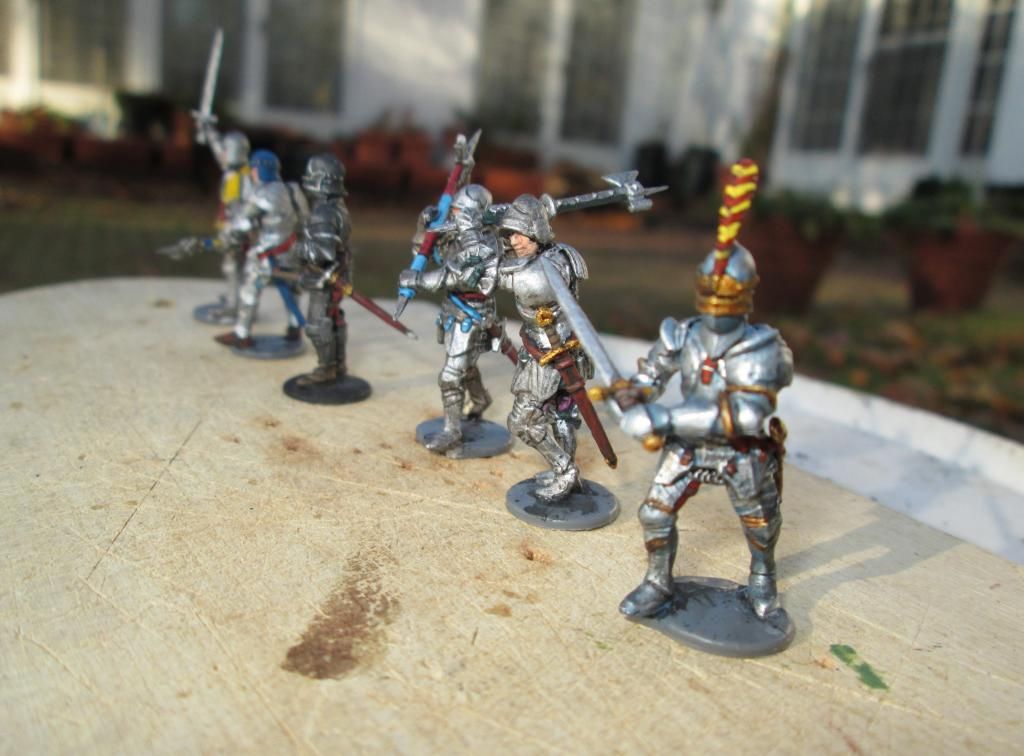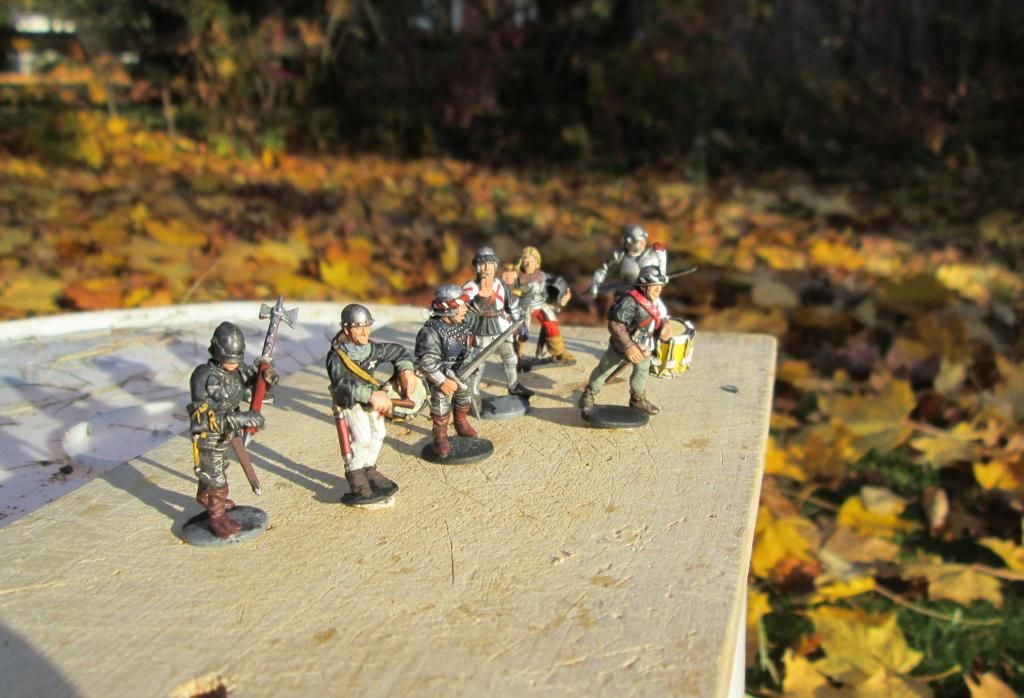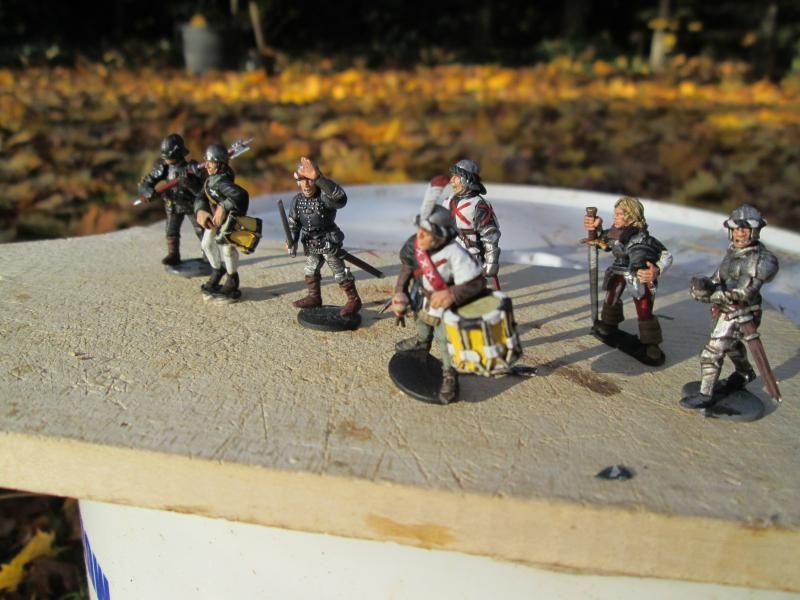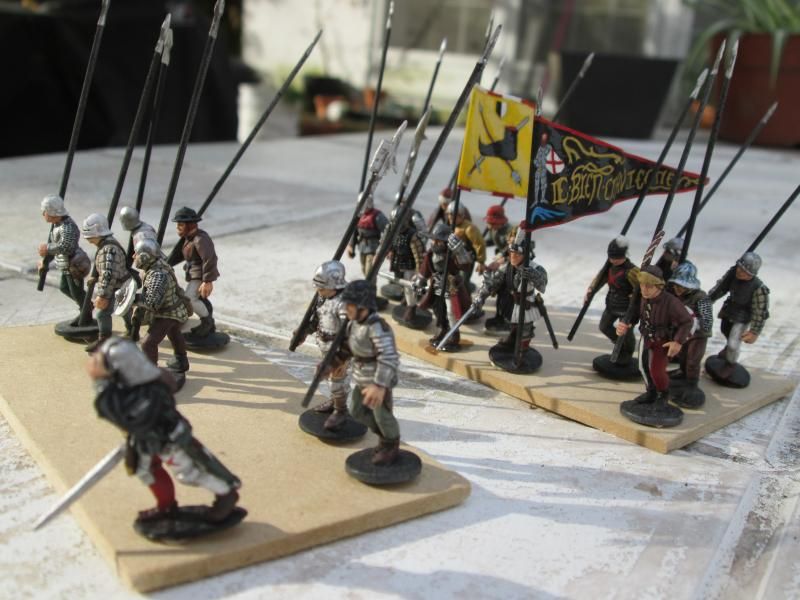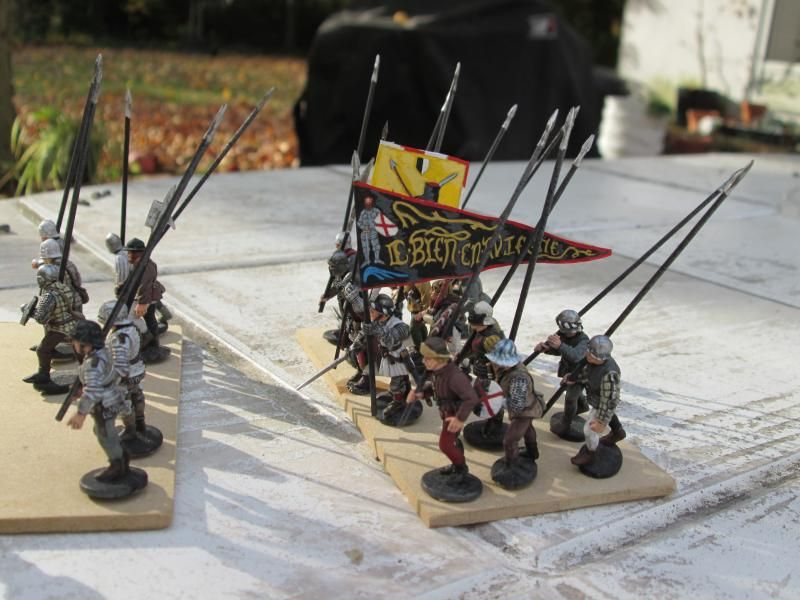Like so many rebellions planned from abroad, Lincoln's campaign depended on widespread popular support, and the exiles at Margaret's court in Mechelen doubtless imagined droves of disaffected noblemen would flock to the Yorkist banner. As is so often the case, however, things turned out rather differently in the event. Most of Yorkist England was dead, won over by Henry VII's magnanimity, or simply too tired of war to take to the field. The Yorkist aristocracy had been severely culled at Bosworth, and those lucky enough to survive (including Lincoln) had gladly accepted Henry's offer of a general pardon to his defeated enemies, only one of whom lost his head after the battle.
Lincoln and his army landed in Lancashire and immediately began to march across the North, the stronghold of Ricardian sympathy. But the Yorkist turnout was poor, perhaps about fifteen hundred men. Of them, only three were of any great standing: Sir Thomas Broughton and two Scropes (perennial enemies of John of Gaunt's line), the lords Masham and Bolton. The rest were gentlemen, knights, and minor nobles, primarily from the North, who out of old friendship and loyalty turned out to fight for the boy-king. It's likely that Lincoln hoped to bolster his army with men from the formerly Edwardian Midlands, where his own lands lay, for it was on his march South toward the Midlands that he was intercepted by the Tudor army.
Henry was still in his 'magnanimous phase' in '87, so most of the English survivors of Stoke got off with attainders or heavy (sometimes crippling) fines. The records of the legal proceedings against these men offer us a fairly precise list of the Englishmen who turned out for White Rose.
Left to Right: Sir Robert Percy of Scotton, Comptroller of the Household under Richard III; John, Lord Scrope of Bolton (fined and kept under house arrest); and David Thomas, commander of the Calais garrison (killed in battle).
Right to Left: Francis, Viscount Lovell (thought to have starved to death while hiding in his house); Sir Richard Harliston, Governor of Jersey (attainted, fled to Burgundy); and Clement Skelton (attainted).
The figures are mainly straight out of the Foot Knights box, though I built David Thomas from the Mercenaries box to give him that "professional soldier" feel. Wherever possible, arms and colors are authentic. The very Burgundian salet/plume combination may seem out of place for an Englishman, but Lovell fled to Mechelen in 1486, and I imagine the ever-generous Margaret bought him a new armor for his troubles. In any case, I've always imagined him as a bit of a dandy and wanted him to look a bit more dashing than the rest.
Wednesday, November 19, 2014
Friday, November 14, 2014
Officers
A few German officers and drummers for Schwartz's company. Some will wind up in the pike block, and others will be sprinkled around here and there.
I should say at this point that the livery colors, like the banners, are entirely conjectural. Black seemed appropriate for a man named Schwartz, (armorial "punning" was not uncommon in the Middle Ages), and white was a natural choice for the complement. I haven't yet decided whether the red saltire is Schwartz's own or the Duchess of Burgundy's, but it looks sharp and matches the arms of the Fitzgeralds, who will make an appearance later on. As late as 1486, Schwartz was in the service of the Holy Roman Emperor, and the yellow drums are a nod to Schwartz's former employer.
Figures are mainly Perry (both the Mercenary and Foot Knights sets), with two Foundry Swiss, sans tête. Foundry's sculpts have so much character, but the heads are just too broad and had to be replaced.
I should say at this point that the livery colors, like the banners, are entirely conjectural. Black seemed appropriate for a man named Schwartz, (armorial "punning" was not uncommon in the Middle Ages), and white was a natural choice for the complement. I haven't yet decided whether the red saltire is Schwartz's own or the Duchess of Burgundy's, but it looks sharp and matches the arms of the Fitzgeralds, who will make an appearance later on. As late as 1486, Schwartz was in the service of the Holy Roman Emperor, and the yellow drums are a nod to Schwartz's former employer.
Figures are mainly Perry (both the Mercenary and Foot Knights sets), with two Foundry Swiss, sans tête. Foundry's sculpts have so much character, but the heads are just too broad and had to be replaced.
Sunday, November 9, 2014
Almains
About a quarter of Lincoln's army was composed of mercenaries hired by Margaret, Dowager Duchess of Burgundy. Most sources refer to them as "Germans," presumably since they were led by Martin Schwartz of Augsburg, but there's no conclusive contemporary description of them. In all likelihood Schwartz's company also contained Swiss, Burgundians, Flemings, and perhaps even Italians. I'm trying to give a basically German impression, but there are a few Swiss and Burgundians in the ranks as well.
Two bases of pike will form the core of Schwartz's contingent. I like my bases packed with men, and when they're filled out properly they should look good and dense - a fine target for Oxford's archers. The first base will have a few officers and more of the heavily armored men, as was customary. Since they'll be deployed together, the standards will sit right in the middle of the block.
The flags are purely conjectural. The yellow one I imagine as Schwartz's own banner. Schwartz was the son of an Augsburg shoe-maker, so I adapted the Wappen of the Shoe-makers' Guild by crossing the (extant) arrow with a sword and adding Schwartz's black-and-white colors. Guild banners were sometimes carried into battle, so it doesn't seem like too much of a stretch, and it evokes the Bunschuh flags that became notorious three decades after Stoke. The black standard is meant to signify Margaret of Burdungy's financing of the campaign - her blessing, so to speak, of Schwartz's company. It features her personal motto, Bien en Aviegne ("may Good come of it"), which appears on a number of her personal commissions with, strangely, some of the 'n's written backward. The figure near the hoist is Gangulphus, a Burgundian saint venerated by shoe-makers and often shown opening a fountain with his sword. The standard also contains a variant on her late husband's flint-and-steel emblem. I don't know whether this is good heraldic form, but it's so neat a design that I couldn't help including it.
Some handgunners, still awaiting an officer and maybe a musician. I suspect the man on the left is an Italian. Not thrilled with the flag, though.
I bought the Perry Mercenaries kit about 18 months ago but never got past assembling it, and it's only recently that I've knuckled down and painted them. There are a few somewhat altered Foundry Swiss in there as well. The next step will be to add some officers and a few metal pikemen to fill in the gaps.
Two bases of pike will form the core of Schwartz's contingent. I like my bases packed with men, and when they're filled out properly they should look good and dense - a fine target for Oxford's archers. The first base will have a few officers and more of the heavily armored men, as was customary. Since they'll be deployed together, the standards will sit right in the middle of the block.
The flags are purely conjectural. The yellow one I imagine as Schwartz's own banner. Schwartz was the son of an Augsburg shoe-maker, so I adapted the Wappen of the Shoe-makers' Guild by crossing the (extant) arrow with a sword and adding Schwartz's black-and-white colors. Guild banners were sometimes carried into battle, so it doesn't seem like too much of a stretch, and it evokes the Bunschuh flags that became notorious three decades after Stoke. The black standard is meant to signify Margaret of Burdungy's financing of the campaign - her blessing, so to speak, of Schwartz's company. It features her personal motto, Bien en Aviegne ("may Good come of it"), which appears on a number of her personal commissions with, strangely, some of the 'n's written backward. The figure near the hoist is Gangulphus, a Burgundian saint venerated by shoe-makers and often shown opening a fountain with his sword. The standard also contains a variant on her late husband's flint-and-steel emblem. I don't know whether this is good heraldic form, but it's so neat a design that I couldn't help including it.
Some handgunners, still awaiting an officer and maybe a musician. I suspect the man on the left is an Italian. Not thrilled with the flag, though.
I bought the Perry Mercenaries kit about 18 months ago but never got past assembling it, and it's only recently that I've knuckled down and painted them. There are a few somewhat altered Foundry Swiss in there as well. The next step will be to add some officers and a few metal pikemen to fill in the gaps.
Bien en Aviegne!
This blog will track my efforts to recreate the army of the Earl of Lincoln as it was on the morning of 16 June, 1487, when it gave battle to the Royalists south-east of the village of East Stoke. I've been ogling Simon Chick's various blogs for years now, not to mention a few others (Army Royal comes to mind). So now I've got enough to put on display, it seems like a good idea to start my own plog. And even though the army's only in its early stages, there's been a lot of revising and reimagining, so I'd like to have a place to keep track of my thoughts and plans as they evolve.
I'll be using the Basic Impetus rules (they're free!), but in all likelihood the army will just be for display, since there's no opportunity for wargaming where I live. The Impetus website has an army list for Yorkist pretenders, but it's far too heavy on the English, and I've reshuffled it to fit the ethnic composition of the Yorkist army a bit more closely:
Earl of Lincoln (Commander)
1 x Men at Arms
1 x Billmen
1 x Longbowmen
3 x Irish
2 x Pike
1 x Handgunners
This arrangement is pleasingly diverse and much closer to the actual English:Irish:German ratio (2:1:1) of Lincoln's army. There will be a couple of vignettes and extra command stands as well.
So, as the title says, may good come of it!
I'll be using the Basic Impetus rules (they're free!), but in all likelihood the army will just be for display, since there's no opportunity for wargaming where I live. The Impetus website has an army list for Yorkist pretenders, but it's far too heavy on the English, and I've reshuffled it to fit the ethnic composition of the Yorkist army a bit more closely:
Earl of Lincoln (Commander)
1 x Men at Arms
1 x Billmen
1 x Longbowmen
3 x Irish
2 x Pike
1 x Handgunners
This arrangement is pleasingly diverse and much closer to the actual English:Irish:German ratio (2:1:1) of Lincoln's army. There will be a couple of vignettes and extra command stands as well.
So, as the title says, may good come of it!
Subscribe to:
Posts (Atom)

